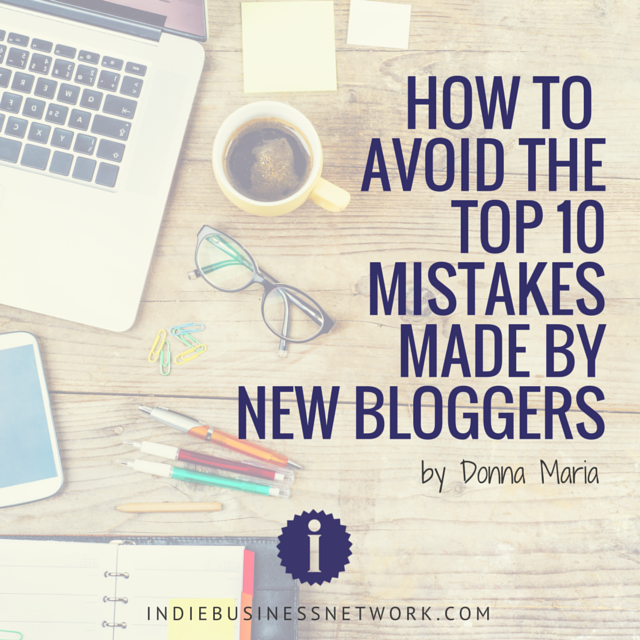If you are a new blogger, chances are your feelings about blogging vacillate between intense hatred and enthusiastic overkill. This post, if you act on it, will change all of that. You may not believe this, but I once hated blogging. (I talk more about this here.)

Forcing myself to blog regularly ensured that I made pretty much every single mistake a new blogger can make, and this post tells you about 10 of them so you can avoid them. Here goes.
Mistake No. 1: Not using the permalink for single blog posts
Each blog post you publish has a unique link, or “permalink,” for that blog post. For example, the permalink for this post is http://www.indibusinssnetwrk.com/avoid-new-blogger-mistakes. Each time you publish a post, change the default link generated by your blogging platform to something that describes your post in a few words. This avoids the link to your post being something like YOURURL/?79~blogpost instead of YOURURL/avoid-new-blogger-mistakes. Each link may get your site visitor to the correct place, but only the latter one does it in a way that makes your site (and therefore your business) look polished and professional.
Mistake No. 2. Focusing too much on comments and not enough on sharing
After using it for many years, I recently removed the Disqus comment system from my blog. In its place, I added options to share my posts on social media. Focusing too much on getting people to comment at your blog is like trying to keep the conversation confined to your blog. While it's nice to have community at your blog, you want to put the most effort into encouraging conversation in other places — the places where your customers are: on social media and reading your newsletter in their inboxes.
Make it easy for people to share your blog posts, and make it easy for them to sign up for your newsletter.
Mistake No. 3. Not categorizing your blog posts
The upper right sidebar of each page of this blog contains a dropdown menu of the Categories at this blog. As you can see, I blog a lot about Social Media and Leadership, and less about #IndieCruise. The feature operates like the Table of Contents in a book, making it easy for you to quickly determine whether my “book” (blog) contains information of interest to you.
Add Categories to your blog to make it easy for people to see more than your last few blog posts. You could also use tags for this, but I prefer Categories.
Mistake No.4. Maintaining too many categories at your blog
Too many categories overwhelms people, and you know that **nothing** happens when people are overwhelmed. Like the Table of Contents in a book, your blog should contain only the Categories that are useful to identify your areas of focus.
A few years ago, I had 22 categories at my blog. It was ridiculous. I currently have 12 and I'm trying to whittle that down to 10.
For more information, read Should You Reorganize The Categories At Your Blog?
Mistake No. 5. No clear, full-size image or video supporting each post
While big is not better when it comes to your product line, big is definitely better when it comes to images at your blog. To be effective, a blog post must contain at least one big, clear, colorful image. As the world becomes more accustomed to using small mobile devices to enjoy huge images on Facebook, Instagram and Twitter, the images at your blog must be big enough (and clear enough) to get people's attention.
The photos at my blog are generally at least 600×600 pixels because that size fits well in the text area at my blog. Try out a few sizes and see what works for your text area. Once you are comfortable with a particular size, you may wish to consider using it for each blog post so your blog has a neat, organized and uniform look.
”
Donna Maria, Indie Business Network
Mistake No. 6. Post are too long and/or too hard to digest
Many of my blog posts are on the meaty side, but I am careful to add areas of text that make it easy for you to skim my main points. This post is a good example. Notice how easy it is to skim my 10 points. Each one is separated by space, a number and a header in a different color and font. The way it's organized allows you to read the title to see if the information might interest you. If it does, you can skim the 10 points and see if any of them apply to you. If any do, you can read just those few or you can read them all. You can quickly skim, and then read or move on.
Mistake No. 7. Not including a call to action
Give people something to do so that, if they do not leave your site having taken no action at all, it's not because you didn't expose them to another alternative. You want your blog posts to make a difference in people's lives, so make it easy for them to take some kind of action after reading them. Examples of actions you can suggest include the following:
Buy a product.
Download a hand-out.
Add a comment.
Share on social media.
Subscribe to your newsletter.
Follow you on social media.
Mistake No. 8. Making every post a promotional post
People will not trust or like your blog if every post is about how great your products are and how they should buy them. Yes, include promotional posts, but include as lest as many posts containing information to enhance your customers lives and complement the buying experience. This will be different for everyone and the only way to determine what works is to know your target audience figure it out by engaging with them.
Mistake No. 9. The introductory text is weak and non-specific
If the first few sentences of your post do not match the title of the post, people will be confused and disinterested. Grab people's attention with a clear title, and follow it up quickly with relevant information that invites them to quickly dive in for more.
Mistake No. 10. Posts are too frequent or too infrequent
A blog post with no entries for many months is a signal to people that you are not paying attention to your business. This may not be a fair conclusion, but the truth is that a blog with no blog posts is alike a website with no products available for purchase. What's the point? Whether it's weekly or bi-monthly (or whatever), stick as closely as you can to a blogging schedule so you can avoid this issue.
The opposite problem is blogging too much. This is not as big a problem as blogging too infrequently, but if people subscribe to your blog via their inboxes, a daily blog post can be overwhelming. Every situation is different. Consider all important factors, including your customers' preferences and your personal lifestyle desires, when deciding how often to post.
(Currently, I am leading my Indie Business Network members in a 30-day blogging challenge, and we are posting every day for 30 straight days. At the end of this period of time, I will return to my regular schedule of three or so posts per week.)
Question
What did I miss? What other common mistakes do new bloggers make, and how would you suggest they fix them? I would love to know your thoughts and feedback in the comments below, or share on Facebook, Twitter and LinkedIn.



